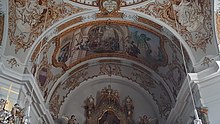St. Vitus (Kirchweidach)
The parish church of St. Vitus is the Catholic parish church of Kirchweidach ( Upper Bavaria ). It is recognized as "one of the highest quality country churches of the late Rococo in Altbaiern " and belongs to the parish association Kirchweidach in the dean's office Altötting of the diocese of Passau .
history
The church was built between 1770 and 1774 by Franz Alois Mayr and from 1771 by the builder Joseph Lindtmayr in the late Rococo style. The interior was designed by the church painter Franz Joseph Soll according to the image program developed by Pastor Josef Kaspar Kolberer from Feichten. The solemn consecration took place in 1787 by the Bishop of Chiemsee, Prince Franz Xaver von Breuner . Kirchweidach was originally a branch church of the parish Feichten . Pastor Ludwig Mittermaier set up an exposition in 1891 , and in 1896 Kirchweidach was elevated to an independent parish. The interior was restored in 1978/1981 with advice from the Bavarian Institute for Monument Preservation. The exterior was restored in 1973/1974 and 2000/2001.
architecture
The building consists of a cruciform central room with a dome, which is inscribed in a rectangular floor plan with bevelled corners. The east tower is closed off by a three-tiered onion dome that is visible from afar . The interior is closed with barrel vaults, the central square with a dome. The oratorios, the sacristy and the staircases are built into the corner rooms . The structure is divided by flat, marbled pilasters , above the entablature by stuccoed and brocaded belts .
The painting is a work by Franz Joseph Soll, which was created in 1775 according to the chronogram on the cartouche on the choir arch . The circular dome fresco over pendentives with rocaille cartouches and painted stucco reliefs of the evangelists dominates the interior of the church. In accordance with Kolberer's image program, Soll composed five scenes from the legend of the titular saint in impressive pseudo-architecture with triumphal arches and landscapes. In the center are the Holy Trinity and the Glory of St. Vitus . In the choir painting, St. Vitus is shown in the dungeon; to the left and right of it is an emblema of the night with Latin inscriptions ("he refreshes everyone") and of the day ("he illuminates everyone") with reference to the high altar image in cartouches. The fresco above the gallery shows how the saint is thrown to a lion, under the gallery the expulsion of the changers from the temple by Christ ( Mt 21 : 12-13 EU ) can be seen. Two monochrome depictions of court parables belong to this scene. One shows the segregation of wheat and weeds after the harvest ( Mt 13.30 EU ), the other shows the segregation of the fish after the catch ( Mt 13.48 EU ).
The handover of the deed of donation from the Bavarian Duke Theodo II to St. Rupert (who points to the miraculous image of Altötting ) can be seen above the north side altar . At the edge of the picture there is a self-portrait of Solls with his wife. The declaration of Benno von Meissen as patron of Bavaria is shown above the southern side altar , after the bones of the saint had been transferred to Munich in 1576 by order of Albrecht V.
Furnishing
Altars
The high altar is designed with a magnificent column structure that fills the eastern end wall. It was probably created by Johann Georg Kapfer in 1785. In the high altar picture of Soll from 1784, the martyrdom of St. Vitus is shown in boiling oil, with his foster parents behind them. In the altar extract , the saint is awaited by the Trinity in heaven. The main picture is flanked by assistant figures of Saints George and Florian .
The pictures in the side altars are both by Soll from 1795 and depict the Visitation of Mary (left) and Saint Leonhard (right), the second patron saint of the church and the community. The pulpit was created in 1795 together with the side altars. A gilded relief of the Good Shepherd can be seen on the front, and putti with symbols of faith, love and hope on the sound cover . A hand with a crucifix is attached to the pulpit as a reference to ( 1 Cor 1.23 EU ).
organ
The organ was a work by Florian Unterholzer from 1834 and was replaced in 1986 by a work by the Schmid company from Kaufbeuren. The confessionals and stalls were created around 1788.
Bells
Four bells in the tones hang in the tower of the parish church: es 1 f 1 g 1 b 1 (filled in Durmotiv)
The large and the second smallest bell were cast in 1947 by Karl Czudnochowsky in Erding in the material Euphon. The second largest bell was also cast from bronze by Karl Czudnochowsky in Erding in 1949. The smallest bell was also cast from bronze by Ludwig Strasser in Burghausen in 1841.
Surroundings
The soul chapel south of the church was built in the 16th century and consists of a three-bay nave with a reticulated vault and a five-eighth corner . Inside there is a neo-Gothic altar depicting the seven refuge , flanked by Daniel and Job; furthermore a picture of Mariahilf with a depiction of the root Jesse from the 18th century.
literature
- Kilian Kreilinger: Catholic parish church St. Vitus Kirchweidach (small art guide; vol. 176). 3rd edition Verlag Schnell & Steiner, Regensburg 2004, ISBN 978-3-7954-4168-5 .
Web links
Individual evidence
- ^ Georg Dehio : Handbook of German Art Monuments. Bayern IV: Munich and Upper Bavaria. Deutscher Kunstverlag, Munich, Berlin 2006, ISBN 978-3-422-03115-9 , pp. 584-585.
Coordinates: 48 ° 5 ′ 7.5 ″ N , 12 ° 38 ′ 31.1 ″ E





